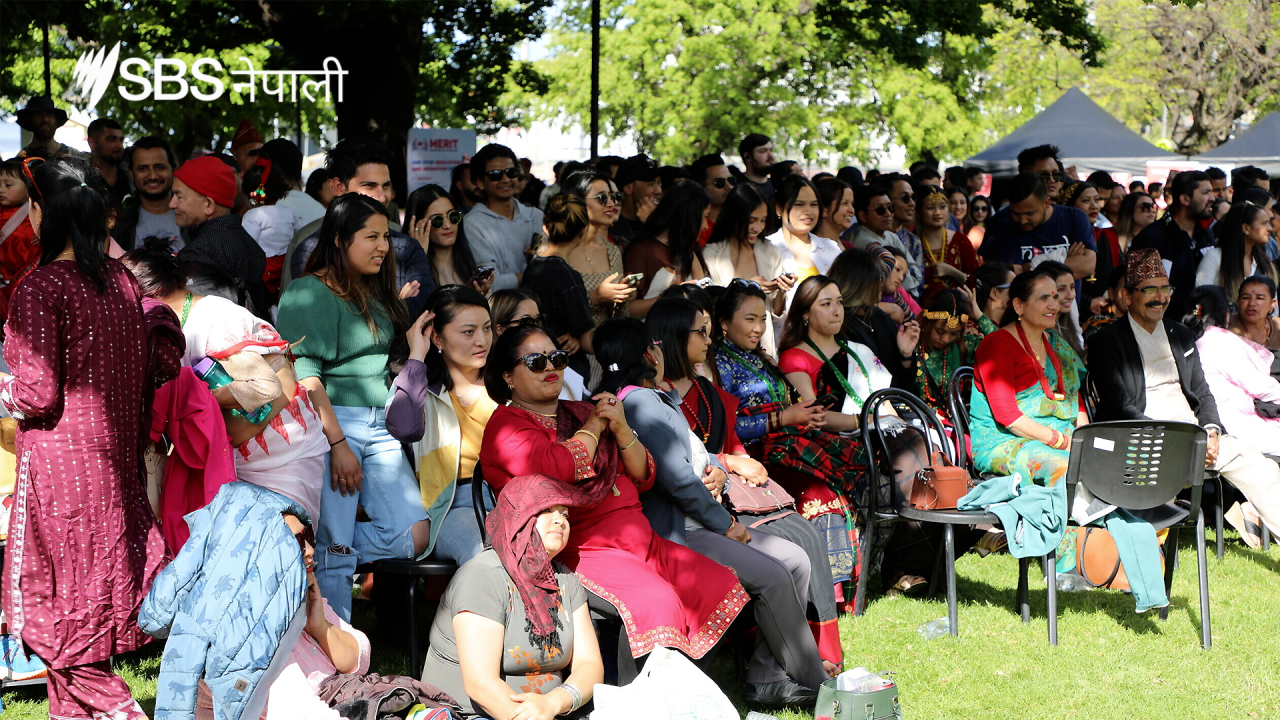

This article is more than 2 years old
Mha Puja: The Newari community welcome the new year by worshipping their body and soul
In Nepal, they used to welcome their new year with a self-worshipping festival. Now the Newari community are keeping the tradition of “Mha Puja” alive in Australia too.
Published 17 October 2022 11:59pm
Updated 18 October 2022 12:37pm
By Krishna Pokhrel
Source: SBS
Image: Newari community members participate in a Mha Puja event organised by Guthi Australia. (Suman/Guthi Australia)
Newars, the indigenous settlers of the Kathmandu Valley, are one of the largest ethnic communities in Nepal.
During the five-day Nepali festival of “Tihar”, the Newari people not only celebrate their new year but also participate in the unique “Mha Puja” tradition.
Deepta Shrestha is a former president of Guthi Australia (GA), a community organisation representing the Newari people in the country.
He explains that “Mha Puja” literally means the worship of oneself, with "mha" meaning body and "puja" meaning worship.
Simply put, ‘Mha Puja’ means ‘celebration of one's soul’ or worshipping of your soul.Deepta Shrestha, former president of Guthi Australia
Mha Puja generally falls on the fourth day of Tihar, one day after the new moon of late October or early November.
This year, the Mha Puja is being observed on Wednesday, 26 October.
“As the new moon rises, the new year starts. Celebrating Mha Puja is also believed to open a new dimension in life,” says Mr Shrestha.
Situ Shrestha lives in the regional Victorian city of Geelong.
She tells SBS Nepali that it has been almost a decade of her celebrating this unique festival in Australia.
“It’s been eight years since I celebrated Mha Puja with my immediate family members, but it makes me happy to celebrate here with my friends as well,” she says.
A unique celebration
For Mha Puja, family members sit together on the floor in front of an intricate circular drawing or “mandala”, which includes an eight-petalled lotus overlayed with water, oil and rice flour, explains Mr Shrestha.
“The first mandala represents Janmaraj (birth), and then it’s the mandalas of all the family members, and then the last one represents Yamaraj (death).”
According to him, the number of mandalas depends on the number of family members.
During the ritual, each family member must be seated in their respective mandala with the head of the family sitting on the mandala in the centre.
Deepta Shrestha says the Newars are a very diverse community, and every family will have different-looking mandalas in terms of colour and presentation.
The ceremony starts with the worshipping of the elephant-headed Hindu deity Ganesha by the family patriarch, says Mr Shrestha.
"Ganesha's mandala requires skunda (a specially designed brass or silver jug), tasi (citron), various fruits, sagun (auspicious foods) and aaila (homemade liquor) for puja."

Aaila, or raksi, is a traditional homemade rice liquor, an important part of the Newari culture. Source: Supplied Credit: SUMAN
"First, the women apply tika, a mixture of red or other coloured vermillion powder and raw rice grains that are used to show respect and devotion," Mr Shrestha said.
"Then they perform aarti, which involves the waving of itta (lighted wicks made from white cotton cloth dipped in mustard oil) before deities in a spirit of gratitude, and ghwalla, the pouring of flower and barley grains from the head."
Mha Puja ends with sagun, the ritualised presentation of auspicious food such as boiled egg, shallow fried ginger garlic, dried fish and dried meat, bara (an appetiser of spiced lentil patties cooked in a thick-bottomed pan and topped with eggs, minced vegetables or meat), and aaila.
“Each item in sagun represents different elements of the earth: the egg represents air, fish represents sea or water, bara represents space, meat represents earth, and aaila is for fire,” Deepta Shrestha told SBS Nepali.
Family members must remain in their designated sacred spot, mandir, throughout the process.
“They must sit and wait for their turns,” Situ Shrestha says.
She adds that the aarti in each family member’s mandala is protected to stop it from extinguishing.
When all family members finish eating the sagun, the female head of the family cuts the side of the tasi, the other holds a broom, and another one holds hasa (a traditional Nepali braided bamboo tray), to wipe off the mandir starting from the end towards Ganesha.

Pouring flower and barley grains during Mha Puja. Credit: Suman/Guthi Australia
Preserving culture for future generations
For Deepta Shrestha, Mha Puja provides an opportunity for Newari kids born here in Australia to learn about their origins.
“Passing knowledge from one generation to another is a way of preserving our culture. Young kids get an opportunity to know their background, and hopefully, they will pass that to future generations,” he says.
Situ Shrestha, who is a social worker by profession, says the occasion is highly inclusive.
No matter your caste or religion, there is no barrier to celebrating. It brings us together, and I believe that’s the beautiful essence of Mha Puja.Situ Shrestha
She adds that the event is especially important for Nepali students in Australia who have family back home they have not been able to see for a long time.
“Unfortunately, many Nepali students are struggling with mental health issues; these kinds of events help them socialise and offer support,” she says.
Share
